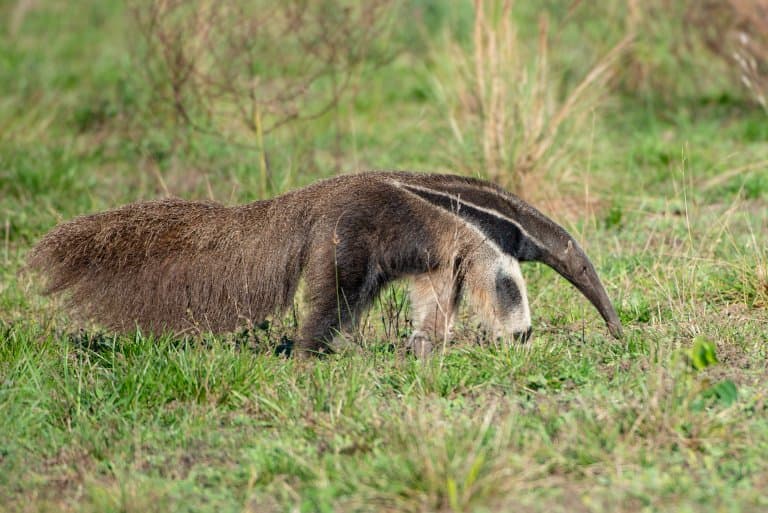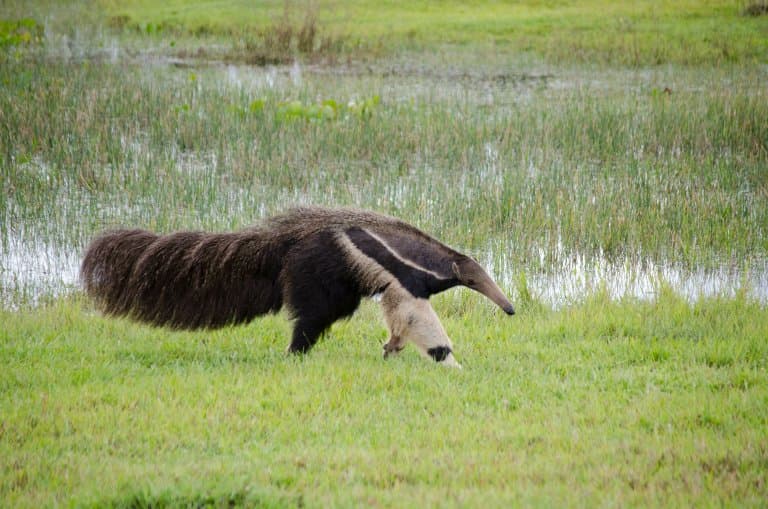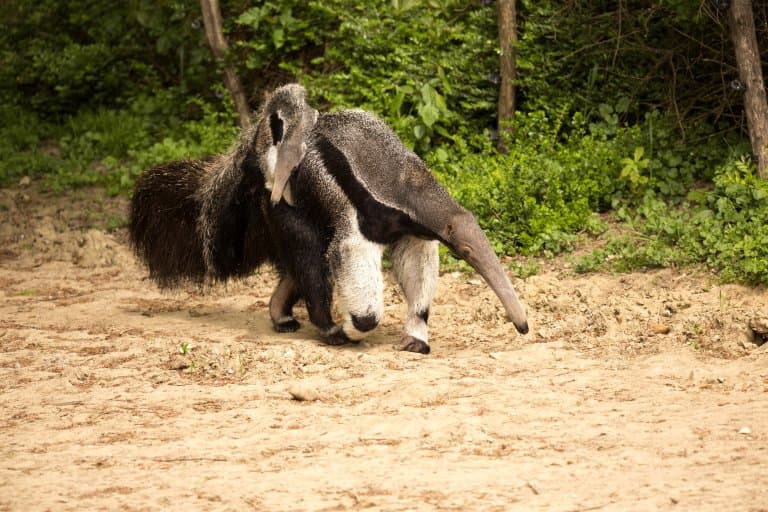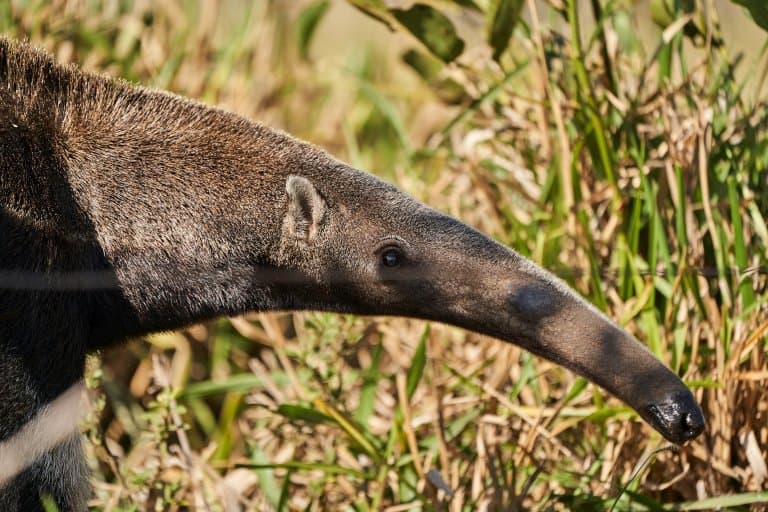Giant Anteater Profile
The giant anteater is one of the most unique mammals in the world. It’s medium-sized and insectivorous, and recognisable for its elongated snout, bushy tail and long sticky tongue.
They are found in the grasslands and rainforests of Central and South America. Most live in Brazil, but they can be found in areas surrounding Brazil, and into Panama.

Giant Anteater Facts Overview
| Habitat: | Grasslands and rainforests |
| Location: | Central and South America, specifically Brazil and surrounding regions |
| Lifespan: | Up to 16 years |
| Size: | 5ft 11 – 7ft (182 to 217 cms) |
| Weight: | 27 to 50 kg |
| Color: | White with black bands and a brown tail |
| Diet: | Ants and termites |
| Predators: | Jaguars and pumas |
| Top Speed: | 48 kph (30 mph) |
| No. of Species: |
1 |
| Conservation Status: |
Vulnerable |
The giant anteater is one of 4 species of anteaters and the largest member, measuring between 6-7 feet in length, and weighing between 27-50kg.
They are mostly nocturnal and solitary creatures, except when breeding and mothers bringing up their young. Anteaters will mark trees with urine to advertise their presence.
Giant anteaters spend much of their time foraging for food, and they like to diet on termites and ants, using its fore claws to dig and its long sticky tongue to slurp them up.
Believe it or not but anteaters are actually quite similar to pigs. As a result, when it comes to their names, you may find that they’re familiar! A male anteater is called a boar, while a female is known as a sow. However, young anteaters put a spin on that pattern, with them being referred to as pups.
As of right now, the giant anteater is considered a vulnerable species. Surprisingly, despite their large size, one of the most common sources of population decline comes from car collisions. They also suffer from habitat loss, pollution and poaching for their fur and bushmeat. 1
Interesting Giant Anteater Facts
1. It’s the largest type of anteater
There’s actually a lot of truth to the giant anteater’s name.
There are four species of anteaters – Other than the giant anteater, there is also the tiny silky anteater (Cyclopes didactylus), northern tamandua (Tamandua mexicana), and southern tamandua (Tamandua tetradactyla).
However, compared to those other three, the giant anteater is by some distance the largest!

2. It is the only living species in the genus Myrmecophaga
Although there are other species of anteaters, they aren’t as closely related as you’d think.
Typically, related species are all in the same genus. Some are even in the same species! However, that isn’t the case with the giant anteater.
The giant anteater is the only living member of the genus Myrmecophaga. Other anteaters, however, do share an order with the giant anteater, with all species being in the Pilosa order – which includes sloths.
4. They can flick their tongue in and out of their mouths 160 times p/m
Incredibly this is nearly three times per second!
Their tongues can measure up to 2-feet in length, covered in sticky saliva and used to slurp up termites and ants. When feeding, giant anteaters swallow almost continuously.
3. Their scientific name means ‘three fingers’
The giant anteater got its scientific name ‘Myrmecophaga Tridactyla’ from Carl Linnaeus in 1758.
Despite ‘tridactyla’ meaning three fingers, it has five toes on each foot! They resemble a bears, with long, sharp claws.
5. They can consume 30,000 insects a day
They visit up to 200 termite or ants nests a day and spend on average around a minute feeding, before moving on to the next nest.

6. They carry their offspring on their back
When you’re as large as the giant anteater, it pays to take advantage of the free transportation. That’s right, with their large size, the giant anteater is able to carry their young on their back.
Usually, a mother will only give birth to a single baby. From there, she’ll feed them for up to six months, though she’ll carry her baby on her back for much longer – sometimes up to a year!

7. Giant anteaters can be aggressive when needed
As insectivores, giant anteaters aren’t interested in hunting large prey, especially mammals. However, they can be aggressive – and downright dangerous – when needed.
This includes when they are scared or otherwise feels threatened. They will typically flee predators, but their front claws are formidable weapons and capable of injuring and killing jaguars and pumas.
While generally shy, there have even be reports and cases of giant anteaters causing fatal injuries when attacking hunters. 2
8. Its sense of smell is 40 times more powerful than a human’s
When you first think of an anteater, there’s probably one thing you think of first: their giant snout!
While their elongated snout and tongue are actually designed in such a way to help them reach and eat their favorite types of prey, the giant anteater also has a strong sense of smell.
In fact, their sense of smell is up to 40 times stronger than a human’s! This is particularly helpful, as it’s thought they don’t have great eyesight.

9. What they eat can depend on where they are located
Ants and termites aren’t always found in the same places. As a result, while the giant anteater is known to eat both, they might not always.
In some areas, ants are more abundant, which means that they make up a larger portion of the giant anteater’s diet. In other places, it’s termites. 3
10. Giant anteaters walk like primates
One of the ways that giant anteaters are able to hunt their prey is with their large claws. However, while claws can be a great tool for digging into ant and termite mounds, it can make walking difficult.
As a result, they walk on their knuckles instead. This means that they can look a lot like chimpanzees or gorillas.
11. They use their tails like a blanket
Outside of their nose, the giant anteater also has another very notable feature: their large, furry tails.
When they sleep, they drape their tails over their body, helping to conserve their heat when the temperatures drop.
12. They’re a popular figure in modern media and ancient stories alike
From movies to books to ancient myths and stories, giant anteaters know how to make an appearance.
They’re an important part of many Indigenous cultures in Central and South America, and, as a result, there are many tales and teachings surrounding them.
Giant Anteater Fact-File Summary
Scientific Classification
| Kingdom: | Animalia |
| Phylum: | Chordata |
| Class: | Mammalia |
| Order: | Pilosa |
| Family: | Myrmecophagidae |
| Genus: | Myrmecophaga |
| Species Name: |
Myrmecophaga Tridactyla |
Fact Sources & References
- Carlos H. de Freitas,Carla S. Justino, and Eleonore Z. F. Setz (2014). “Road-kills of the giant anteater in south-eastern Brazil: 10 years monitoring spatial and temporal determinants”, Wildlife Research.
- Vidal Haddad Junior (2014) “Human Death Caused by a Giant Anteater (Myrmecophaga tridactyla) in Brazil”, ResearchGate.
- James H. Shaw, Jose Machado-Neto and Tracy S. Carter (1987), “Behavior of Free-Living Giant Anteaters (Myrmecophaga tridactyla)“, JSTOR.
